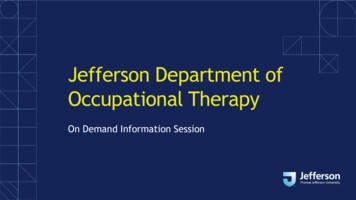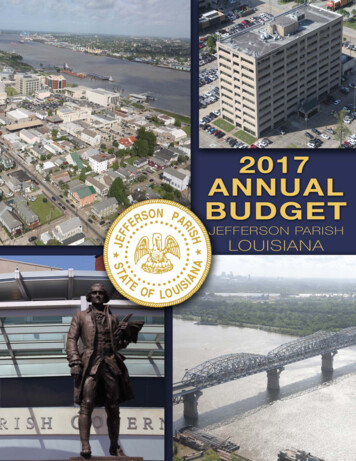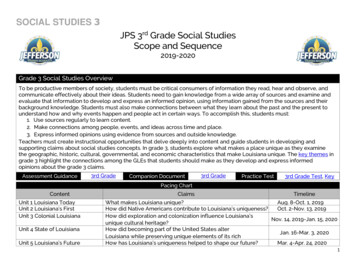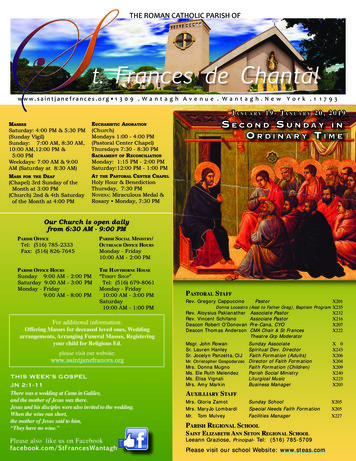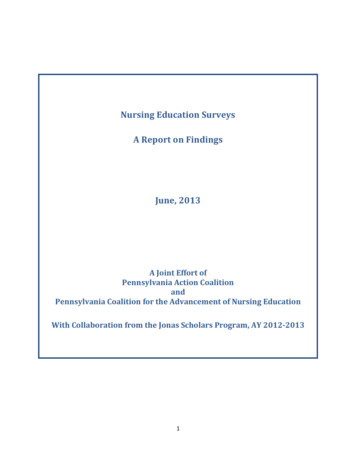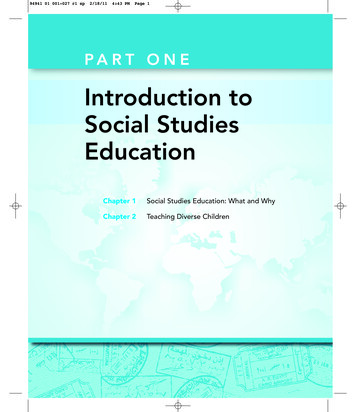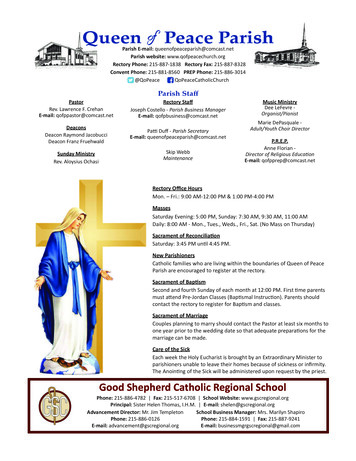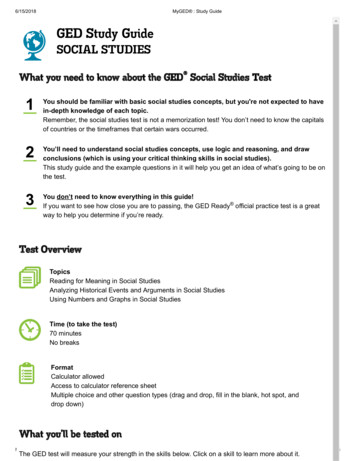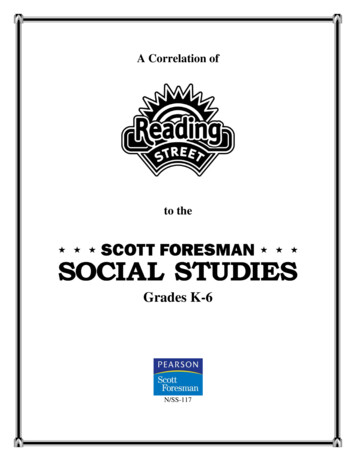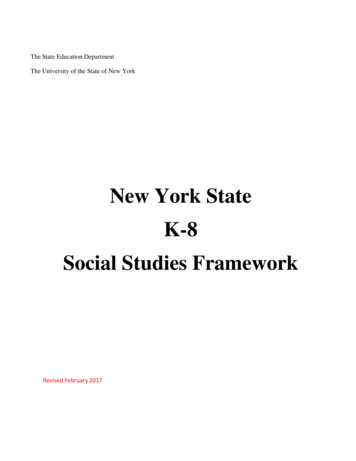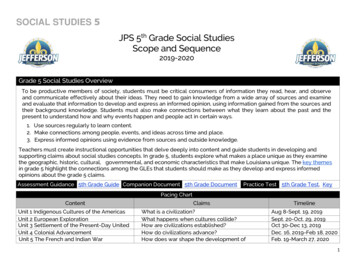
Transcription
SOCIAL STUDIES 5JPS 5th Grade Social StudiesScope and Sequence2019-2020Grade 5 Social Studies OverviewTo be productive members of society, students must be critical consumers of information they read, hear, and observeand communicate effectively about their ideas. They need to gain knowledge from a wide array of sources and examineand evaluate that information to develop and express an informed opinion, using information gained from the sources andtheir background knowledge. Students must also make connections between what they learn about the past and thepresent to understand how and why events happen and people act in certain ways.1. Use sources regularly to learn content.2. Make connections among people, events, and ideas across time and place.3. Express informed opinions using evidence from sources and outside knowledge.Teachers must create instructional opportunities that delve deeply into content and guide students in developing andsupporting claims about social studies concepts. In grade 5, students explore what makes a place unique as they examinethe geographic, historic, cultural, governmental, and economic characteristics that make Louisiana unique. The key themesin grade 5 highlight the connections among the GLEs that students should make as they develop and express informedopinions about the grade 5 claims.Assessment Guidance 5th Grade Guide Companion Document 5th Grade DocumentPractice Test 5th Grade Test, KeyPacing ChartContentUnit 1 Indigenous Cultures of the AmericasUnit 2 European ExplorationUnit 3 Settlement of the Present-Day UnitedStatesUnit 4 Colonial AdvancementUnit 5 The French and Indian WarClaimsWhat is a civilization?What happens when cultures collide?How are civilizations established?How do civilizations advance?How does war shape the development ofcivilizations?TimelineAug 8-Sept. 19, 2019Sept. 20-Oct. 29, 2019Oct 30-Dec 13, 2019Dec. 16, 2019-Feb 18, 2020Feb. 19-March 27, 20201
SOCIAL STUDIES 5Unit 1: Indigenous Cultures of the Americas(29 Days)OverviewStudents explore the characteristics of civilization and consider how the development of various indigenous cultures ofthe Americas exemplifies those characteristicsClaimThe students develop a claim to respond to the overarching question: What is a civilization?Key Connections The Maya, Aztec, and Inca developed large and complex civilizations that flourished economically, socially, andpolitically.Surplus food in the Maya, Aztec, and Inca empires allowed trade to develop, and brought in goods thatcity-states did not have.Development of civilizations across the Americas depended on geographic resources, and sharedcommon characteristics.2
SOCIAL STUDIES 5Unit Terminology and ToolsContent Vocabularycompass rose, map title, map key or legend, grid, cardinal directions, intermediatedirections, distance scale, longitude, latitude, Equator, Prime Meridian, hemispheres,plains, plateau, basin, coast, primary and secondary sources, culture, civilization,society, migrate, Aztec, Maya, Inca, Olmec, Tenochtitlan, nomad, artifact, empire,aqueducts, causeways, astronomy, observatory, bartering,archeologist/anthropologist, indigenous, pyramid, mound, terrace, pueblo, plaza,conquer/conquest/conquistadors, pre-Columbian, explorer/exploration, soldier,sacrifice, architecture, agriculture, rights, citizenship, language, religion, technology,indigenous, nativeDBQ Project CorrelationCLEVER: The Maya: What was their Most Remarkable Achievement?Studies Weekly CorrelationCLEVER: USA Studies Weekly: Ancient America to Reconstruction, Week 3Supplemental MaterialsWorldBook Online: What is a Map?, How to Read Map SymbolsDiscovery Education: The Aztecs, Machu Picchu, Mayans, Chichen Itza, The AnasaziPueblo Bonito, Effects on Native American CultureLDOE Task Item: Indigenous CulturesAssessments LDOE Unit 1 Assessment: Students will participate in a Socratic seminar in response to the question: What does itmean to be civilized? JPPSS Unit 1 Assessment3
SOCIAL STUDIES 5Essential GLEs5.2.1 Describe the origins,characteristics, and expansion ofindigenous cultures and groupsthat existed in the Americasprior to European exploration.Essential content represents the most important concepts to be taught in each unit.Teachers should spend the majority of their time teaching the essential content.Priority Concepts and Content Evaluate the Aztec, Maya, and Inca Empires, and Native American(Northeastern Woodlands, Southeast, Plains, Southwest/Pueblo, Great Basin,Plateau, Northwest Coast) civilizations to determine how the empires exemplifythe characteristics of civilization (large population centers, monumentalarchitecture and art, written language, organized central government,specialization and division of labor, social classes/structures). Describe the social, cultural, religious, and economic characteristics of theMayan civilization (writing system, human sacrifice, stepped pyramids, terracefarming, plazas, clay works). Describe major accomplishments of the Inca empire (roads andbridges, architecture, centralized economy, terrace farming, aqueducts). Explain why roads were so important to the Inca Empire (impact onexpansion of empire). Describe the innovations and products of the Aztec Empire (food, jewels,metals, stones, bones, feathers, medicine, salons, restaurants, drinkingwater, pipes, and roads). Describe the importance of Tenochtitlan’s geographic location, and explainits economic innovations (the market, tribute system, and chinampas floating islands for crops). Explain how agricultural innovations contributed to the Aztec economicsystem. Describe characteristics of Native American tribes (tribes from theNortheastern Woodlands, Southeast, Plains, Southwest/Pueblo, Great Basin,Plateau, and Northwest Coast) before Europeans came to the Americas. Compare and contrast how indigenous cultures developed in North andSouth America, and what likely contributed to the similarities anddifferences.4
SOCIAL STUDIES 55.4.3 Analyze maps from the Ageof Exploration to 1763.Ancillary GLEsPriority Concepts and Content maps of the Maya and Inca empires, and explain the significance of thespread and growth of the empires. Use maps of the Aztec empire to analyze its spread and growth. Analyze maps of Tenochtitlan to explain the importance of the causeways androads in the city. Use maps of pre-Columbian North America to analyze the spread and growthof Native American cultures.Ancillary content represents skills that are used in support of bigger ideas, reviewcontent within a unit, and historical thinking skills. Ancillary content should not be cutfrom instruction.5.1.1 Create a timeline of key events inearly American history fromhe pre-Columbian to 1763.Priority Concepts and Content Create a timeline of indigenous civilizations including the estimated beginningand end of the Maya and Inca Empires, founding of Tenochtitlan, beginning andend of the Aztec Empire, and Native North American civilizations.5.1.2 Examine primary and secondarysources to research early Americancolonial history from the Age ofExploration to 1763.Priority Concepts and Content Analyze artifacts to determine religious, social, cultural, and politicalcharacteristics of the Aztec, Maya, Inca, and Native North Americancivilizations.5.1.4 Produce clear and coherentwriting for a range of tasks, purposes,and audiences through the followingtasks: conducting historical research;evaluating a broad variety of primaryand secondary sources; comparingand contrasting varied points of view;determining the meaning of wordsand phrases from historical texts;using technology to research,produce, or publish a written productPriority Concepts and Content Produce writing explaining why the Maya, Inca, and Aztec are civilizations. Conduct historical research on the characteristics of Native Americancivilizations.5
SOCIAL STUDIES 55.4.1 Differentiate between varioustypes of maps using characteristics,functions, and applications.Priority Concepts and Content Differentiate between physical, political, historical, climate, and resourcemaps, and describe common uses for each.5.4.2 Analyze a map using a varietyof tools.Priority Concepts and Content Describe the locations of the Aztec, Maya, and Inca empires on a map. Use the title, scale, legend, and grid to describe maps from the Aztec, Mayaand Inca Empires. Locate on a map where North American indigenous tribes are located(Northeast, Southeast, Plains, Southwest, Great Basin, Plateau, Northwest Coast).Topic 1: Characteristics of CivilizationStudents develop a “value-free” definition of civilization by identifying the common characteristics of civilizations. Throughoutgrade 5, students explore the question: “What does it mean to be civilized?” For this topic, students understand the meaning ofcivilization as it relates to their society. They identify and define the many characteristics of civilizations, each of whichcontributes to the development of a civilization. They also provide examples from their society. Students are also encouragedto understand their bias and assumptions when defining civilization. Civilizations are often viewed as “advanced societies.” Theproblem with this definition is that it assumes early societies are less civilized than modern-day society because we haveadvanced since that time. As students’ progress through this unit, it is important that they begin to understand that civilizationsare defined as a type of human community with common characteristics and avoid assuming an early society is less civilizedbecause, for example, they used farming to grow food locally rather than mass producing food in factories.GLEsEssential5.2.1Ancillary5.1.4; 5.4.16
SOCIAL STUDIES 5Key Questions What is a civilization?What are the characteristics of a civilization?Timeline: 4 DaysWhile the activities below were inspired by the LDOE’s sample lessons for this topic,many were modified to serve the needs of the teachers in JPS and to correspond to theJPS Student Resource Books. Additional information for each topic can be found in thePriority Concepts and Content section of the Essential and Ancillary GLEs found in theLDOE Companion Document.What is a Civilization?1. Write the word “civilization” on the board and read or project the following definitions. Students can follow along in theStudent Resource Book:a. The stage of human social development and organization that is considered most advanced.b. The process by which society or place reaches an advanced stage of social development and organization.c. The society, culture, and way of life of a particular area.d. The comfort and convenience of modern life, regarded as available only in towns and cities.2. Read aloud two other definitions of “civilization” from the first two paragraphs of Vocabulary,com. Students can follow along inthe Student Resource Book. Ask students: “What do these definitions have in common?” Take notes for the class or annotatethe definitions as students share their answers. Say: “According to many of these definitions, “civilization” is defined byadvancement. However, think about the definition that said, ‘the society, culture, and way of life of a particular area.’ How is thisdefinition different from the other definitions you have read?” Direct students to explain the meaning of “civilization” in the spaceprovided in the Student Resource Book by using their own words and providing a visual. Divide the class into pairs or smallgroups and ask them to identify words and phrases related to “civilization” (Ex. synonyms-area where people live, organizedsociety) and words from the same family (Ex. civil, civilized, citizen).3. Have students turn to the “Class Society” diagram for Maya Civilization in the Student Resource Book. Instruct them toexamine the diagram and answer the following question: “What is a hierarchy?”7
SOCIAL STUDIES 54. Have students turn to the “Characteristics of Civilizations” chart in the Student Resource Book. As a class, discuss how theUnited States is an example of a “civilization.” Define the characteristics, and then, work together to identify modern-dayexamples. Direct students to record definitions and examples during the discussion. (Ex: For “Centralized government or statesystems,” ask students to recall the type of government in the United States and what distinguishes it as such. Project“Citizenship Rights and Responsibilities.” Read the passage aloud to the students, while students follow along in the StudentResource Book. Ask students to explain the difference between a right and responsibility in the space provided in their StudentResource Book. Then, complete the row for “Centralized government or state systems” together.)5. Following the class discussion and completion of the “Characteristics of Civilization” chart, explain to students that they willexplore “what it means to be civilized” throughout the school year in social studies. Tell them that they will study variouscivilizations in order to identify their individual characteristics as civilizations, what happens with two civilizations collide, andwhat happens over time as civilizations grow, change, and mix.Topic 2: The Aztec EmpireStudents examine various sources from Tenochtitlán, the capital city of the Aztec Empire, to determine advancements made bythe Aztec Empire, including social hierarchy (e.g., those closer to the Templo Mayor had a higher status in the society),agriculture, markets and job specialization, system of tribute (e.g., vassals contributed clothing, honey, feathers, etc.), organizedreligion, and an organized system of government (e.g., the Triple Alliance maintained power over the surrounding areas andrequired tribute), and to understand how those advancements exemplify the characteristics of civilization.GLEsEssential5.2.1, 5.4.3Ancillary5.1.1, 5.1.2, 5.4.28
SOCIAL STUDIES 5Key Question What do sources reveal about the characteristics of civilization exemplified by the Aztec Empire?Timeline: 7 DaysWhile the activities below were inspired by the LDOE’s sample lessons for this topic,many were modified to serve the needs of the teachers in JPS and to correspond to theJPS Student Resource Books. Additional information for each topic can be found in thePriority Concepts and Content section of the Essential and Ancillary GLEs found in theLDOE Companion Document.Aztec Empire: Overview1. Say: “We are going to explore several sources from Tenochtitlán, the capital of the Aztec Empire. The Aztec Empire wasan alliance of three large civilizations in present-day Mexico, which began around 1427 A.D. At the height of the AztecEmpire, the city of Tenochtitlán was home to as many as 300,000 people. The Aztec Empire is considered an indigenousgroup, or group that is native to the Americas. This means they lived in the Americas before the Europeans explored andcolonized the Americas. What we know today as the United States was the result of that exploration and colonization. Wewill learn more about the exploration and colonization of the Americas throughout this year.” (Suggestion: As you introducethe Aztecs, you may wish to briefly mention several civilizations which pre-dated and inspired the Aztecs: the Olmecs, theZapotecs, Teotihuacan, and the Toltecs.)2. Have students turn to the “Map of the Americas” in the Student Resource Book. Direct them to label the continents forpoints of reference. Then, have students locate and label the Aztec Empire. They should also determine: Where was theAztec Empire located in relation to modern-day Louisiana? What modern-day country is located where the Aztec Empireonce existed?3. Ask students to start a timeline with the founding of Tenochtitlán in 1325 and the beginning of the Aztec Empire in 1427.Explain to them that they will continue to add events to the timeline throughout the unit. (Note: There is a blank “Timeline of theNative Cultures of the Americas” in the Student Resource Book; however, timelines can also be created on a separate sheet paperor digitally on any of the following platforms: ReadWriteThink, knight lab, timeglider, Sutori, or myHistro.)9
SOCIAL STUDIES 54. Say: “Your goal with the next task is to examine various sources to determine whether the Aztec Empire is a civilization basedon its characteristics. We are going to work together on this task as a model. For the next task, you will work in small groups,and then, independently. Next, students will engage in a similar process for other indigenous cultures in the Americas. Our firststep in this task is to answer the question: ‘What is important about the location of Tenochtitlán?’” As a class, view Maps 1-3 andDiagram 1 of Tenochtitlán in order in the Student Resource Packet. (Note: The original New York State task was intended for 9thgraders; however, specific sources were selected by the LDOE to be used in the 5 th grade classrooms.) (Pages 17-18, 21, & 23 ofthe original New York State task) As needed, teach students about the key features of a map (Ex. title, orientation, scale, legend,and grid) as well as the different types of maps provided (Ex. political map, physical map, road map). To assist students withunderstanding the information in these sources, the Student Resource Book also includes Analyze a Map organizers forstudents to complete with Maps 1-3.5. Have students turn to the “Mapping Tenochtitlán” chart in the Student Resource Book. Instruct students to work with apartner or small groups to examine their findings and record the information in the “Mapping Tenochtitlán” chart. While still withtheir partner or in small groups, conduct a brief discussion about the significance of Tenochtitlán’s location. Encourage studentsto use the conversation stems (Note: LDOE Scope and Sequence pg. 142; conversation stems are included in the front of theStudent Resource Book) and provide evidence from the sources and their knowledge of social studies to support their answers.Guiding questions:a. Where was Tenochtitlán located?b. Why might the Aztecs have chosen that particular location?c. What were the likely consequences of selecting that location?d. What characteristics of civilization are revealed by the location and geography of Tenochtitlán?After the students discuss, have them share their responses and record class notes for examples of the “Characteristics ofCivilizations” from the Aztec Empire. (Suggestion: Post these notes on chart paper for students to refer to throughout the unit.)Aztec Artifacts: Templo Mayor6. Say: “The Aztecs built the great city of Tenochtitlán as the fulfillment of a prophecy. The people who would become theAztecs had wandered Mexico for almost 100 years looking for a specific sign from Huitzilopochtli, the sun god. According to theAztecs, when they saw an eagle perched on a cactus situated on a rock in the center of a lake and eating a serpent, theprophecy was fulfilled and they built their empire around this location, Tenochtitlán. At the center of Tenochtitlán was theTemplo Mayor, which is now buried under modern-day Mexico City. The temple was the largest structure within Tenochtitlánand was built to honor Huitzilopochtli and acted as a government and religious center. Our next step is to look at threearchaeological artifacts to determine what they tell us about the Templo Mayor.” (Note: The hyperlinked images were includedin the Student Resource Book for reference.)10
SOCIAL STUDIES 57. Turn to the three “Templo Mayor Artifacts” in the Student Resource Book. (Note: The Temple Entry Stone was censored in theStudent Resource Book due to nudity in the original photograph.) (Pages 29-31 of the original New York State task) As a class,for each artifact: 1) the Temple Entry Stone), 2) Skull Rack), and 3) Aztec Calendar Stone, ask students to think about each object,and then, make a hypothesis about the purpose of the object (how the Aztecs might have used it). Guiding questions:a. What are you first impressions?b. What is the object made of?c. How big does the object appear to be?d. Is it intact or does it look like parts are missing?8. After viewing the artifacts, have students turn to the “Digging for Clues: Templo Mayor Artifact Analysis, Part One” chart andinstruct them to individually record information from the class discussion in the chart. (Suggestion: As needed, teach studentshow to analyze objects using the resources in Engaging Students with Primary Sources pgs. 46-51 from Smithsonian andThinkfinity.) Next, divide the class into pairs or small groups and have them turn to the “Digging for Clues: Templo Mayor” factsheet, containing all three artifacts. (Note: The Temple Entry Stone was censored in the Student Resource Book due to nudityin the original photograph.) (Page 28 of the original New York State task). Direct each pair or small group to complete “Diggingfor Clues: Templo Mayor Artifact Analysis, Part Two” in the Student Resource Book by using the new information about theobjects to: 1) evaluate their hypothesis and 2) describe what the object reveals about the Templo Mayor. Following the objectanalysis, ask: “What ‘Characteristics of Civilizations’ are revealed by the objects from Templo Mayor?” As students discuss,record class notes of examples of the “Characteristics of Civilizations” for the Aztec Empire. (Suggestion: Post these notes onchart paper for students to refer to throughout the unit.)Aztec Economic Innovations9. Say: “Other important aspects of Tenochtitlán included the market, the “chinampas” (floating islands for crops), and thecauseways. Outside the city was an extensive network of other indigenous communities that were economically tied to theAztec Empire through a system of tribute or taxation. Listen to how one Spanish explorer described Tenochtitlán in 1519, whenhe arrived: ‘These great towns and cues [temples] and buildings rising from the water, all made of stone, seemed like anenchanted vision from the tale of Amadis. Indeed, some of our soldiers asked whether it was not all a dream. It is not surprisingtherefore that I should write in this vein. It was all so wonderful that I do not know how to describe this first glimpse of thingsnever heard of, seen or dreamed of before. — Letters from Bernal Díaz, 1519–1526.’ Our next step is to examine three economicinnovations in Tenochtitlán – the market, the tribute system, and “chinampas” (floating islands for crops) – to determine what‘Characteristics of Civilizations’ they reveal.”11
SOCIAL STUDIES 510. Read aloud “Hernan Cortés, Second Letter to Charles V, 1520” in the Student Resource Book (Page 36 of the original NewYork State task). Say: “As I re-read a portion of Cortés’ letter about the Tenochtitlán Market, locate final innovations or productsof the market.” Reread aloud the following portion of the letter: “more than sixty thousand souls, engaged in buying and selling;and where are found all kinds of merchandise that the world affords, embracing the necessaries of life, as for instance articles offood, as well as jewels of gold and silver, lead, brass, copper, tin, precious stones, bones, shells, snails, and feathers. There areapothecaries' shops, where prepared medicines, liquids, ointments, and plasters are sold; barbers' shops, where they wash andshave the head; and restaurateurs, that furnish food and drink at a certain price. [. . .] An abundant supply of excellent water, isconveyed by one of these pipes, and distributed about the city, where it is used by the inhabitants for drink and other purposes.”11. In the Student Resource Book, allow students an opportunity to create two lists based on information from the letter: finalinnovations (Ex. salons, restaurants, pipes for drinking water, etc.) and final products (Ex. food, jewels/metals/stones, bones,feathers, medicines, etc.). As a class, have students share the lists they created and compile a class list to pull from for the nextactivity.12. Say: “We are going to create “chaîne opératoires,” or operational sequences, for these economic innovations and products. Anoperational sequence looks a lot like a flow chart that highlights each step, material, or invention needed to get to the finalinnovation or product. This will allow us to consider the characteristics of civilizations exemplified by the Aztec Empire.” Havestudents turn to the “Operational Sequence: Tenochtitlán Market” in the Student Resource Book. Select one of the finalinnovations or products from the list that the class developed and create a class operational sequence for the TenochtitlánMarket that identifies the steps in the process which would likely lead to the selected final innovation or product. (Note: Youmust walk students through this step for them to understand the flow being identified. Before starting this activity, examine thecompleted example from the LDOE Scope and Sequence pg. 23.)For a partial example, see below:12
SOCIAL STUDIES 5Students should use the selected class innovation or product to build the first row, and then, branch off the appropriate stepswith directional arrows. For example, the first two process steps would likely be the same steps for “restaurants” as the finalinnovation, so students should start their steps below that square and add the appropriate directional arrows. Additionally, notevery student will describe these steps in the same way. Some students may see more or fewer steps for theinnovations/products. What is important is that students notice the variety of advances needed to get to the final innovation orproduct and that they begin to consider the advances made by the Aztecs. (Note: You may not use all of the boxes provided.)13. Provide students with context about the next two sources, which are labeled Artifact 4 & Artifact 5 in the Student ResourceBook. (Pages 37-38 of the original New York State task).a. For Artifact 4: Codex Mendoza, an annotated manuscript describing the Aztec tribute system, ca. 1535, say: “Thissource is an annotated codex of the tribute system. A codex is an ancient manuscript in book form; a manual. Theyoften explain the way of life of the time period. The Aztecs used the tribute system as a system of taxes to be paidby the other local governments the Aztec Empire controlled. Most of the tribute went to Tenochtitlán.”b. For Artifact 5: Te Papa, Photograph of a model of Aztec chinampas, say: “This photograph is a model of thechinampas, a method of agriculture that allowed the Aztecs to use small areas of fertile land to grow crops on thelake beds that surrounded Tenochtitlán.”14. Have students turn to the “Operational Sequence: Tribute System or Chinampas” in the Student Resource Book. Divide theclass into pairs or small groups and direct them to repeat the same process with one of the new sources (Artifact 4 or 5). Youmay choose to assign half the pairs or small groups to analyze Artifact 4 (tribute system) and half the pairs or small groups toanalyze Artifact 5 (the chinampas). (Suggestion: Students may find it easier to write in pencils so that they have the ability toerase.)For this task, students should:a. Identify the final innovations and products.b. Determine steps necessary to create these innovations or products.c. Create an operational sequence using the sources and the space provided in the Student Resource Book.15. As needed, provide pairs with lists of final innovations or products for each economic innovation.a. Tribute system: capes/waist cloths/clothing, feathers, shields, grain, gold, honey, wood, and copper; names oftowns expected to pay tribute13
SOCIAL STUDIES 5b. Chinampas: wooden posts, woven frameworks, waterways, agricultural tools, crops (seeds), willows, farmers/humanlabor16. As the pairs or small groups work, challenge students to consider the evidence available for their inferences and promptthem to consider what else might have been necessary (Ex. human intelligence, the need or desire for innovation) to buildthis elaborate economic system. Direct pairs or small groups to share their operational sequence with another pair or smallgroup analyzing the same source. Then, direct the new groups to share their operational sequence with another group thatanalyzed the other source.17. Following the source analysis, conduct a brief discussion with partners or small groups. Guiding questions:a. How did the agricultural innovations feed into the Aztecs’ larger economic systems, including the tribute systemand the marketplace?b. How did Tenochtitlán sustain itself?c. What characteristics of civilizations in Tenochtitlán are revealed by your operational sequence?As students discuss, record class notes of examples of the characteristics of civilizations for the Aztec Empire. (Suggestion: Postthese notes on chart paper for students to refer to throughout the unit.)Topic 3: Indigenous Cultures of the AmericasStudents conduct small-group and then independent research on indigenous peoples of the Americas (e.g., the Maya, Aztec,Inca, and various Native American tribes) to identify characteristics of civilization exemplified by the various groups. Studentsalso compare and contrast early American civilizations and make connections between where a civilization was located andthe differences in their characteristics.GLEsEssential5.2.1, 5.4.3Ancillary5.1.1, 5.1.2, 5.4.214
SOCIAL STUDIES 5Key Questions How to indigenous cultures of the Americas exemplify the characteristics of a civilization? How were early civilizations of the Americas similar to and different from one another?Timeline: 18 DaysWhile the activities below were inspired by the LDOE’s sample lessons for this topic,many were modified to serve the needs of the teachers in JPS and to correspond to theJPS Student Resource Books. Additional information for each topic can be found in thePriority Concepts and Content section of the Essential and Ancillary GLEs found in theLDOE Companion Document.Maya, Aztec, and Inca Empires: Small Group Research1. Sa
SOCIAL STUDIES 5 1 JPS 5th Grade Social Studies Scope and Sequence 2019-2020 Grade 5 Social Studies Overview To be productive members of society, students must be critical consumers of information they read, hear, and observe and communicate effectively about their ideas. They need t
